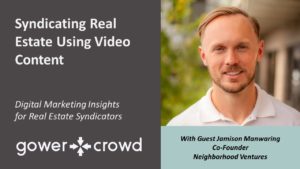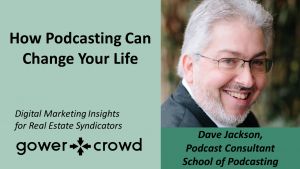Lou Jordano, Building Engines
What World Class Communications Looks Like With 2.5 Billion Square Feet of Office Under Management
 Today's Guest Lou Jordano
Today's Guest Lou Jordano
I am looking at my guest's website - Building Engines - and it's not often that you see these kinds of numbers: 25,000 buildings, and over 2.4 billion square feet managed by their systems. You're going to hear about it today, from my amazing guest, Building Engines (former) Chief Marketing Officer, Lou Jordano.
In this back-to-our-normal-programming episode, you're going to learn from my guest about what works well on social media; how to market to a sophisticated, knowledgeable audience; why LinkedIn is a great place to do your marketing; how to engage that platform, and a whole lot more.
What You're Going to Learn
- How Taking Care of Little Things Goes a Long Way for Your Tenants
- How to Build Relationships Using Social Platforms Like LinkedIn
- How To Communicate with Different Audiences
- How to Provide the Best Building Experience for Your Tenants
- How to Reach the Right Audience Through Content Marketing
- The Power of Webinars
- How to Effectively Engage Different Types of Customers
- And much more!
Listen To or Watch the Full Podcast Here
Show Highlights
How Taking Care of Little Things Goes a Long Way for Your Tenants
Adam: So how exactly do you enhance the tenants' experience? What does that actually mean?
Lou: When you're a tenant in a fancy office building, you want all the things to work properly. If you have an issue, like a light bulb just went out over my head, I want that fixed quickly. You want to make sure that air conditioning is on after hours, if you're working late, or if you have people on your team that are working late. You want to know how much are you spending on all these things, right?
Bringing all that visibility and quick action to the things that matter most, those little details, is really what we're all about. Whether it's having a visitor register at the front security desk in the building lobby and seamlessly get up into your office space on the 32nd floor, where I am; having that visitor experience be really easy and simple, that matters.
How to Build Relationships Using Social Platforms Like LinkedIn
Adam: In what way do you use LinkedIn? do you do any advertising on LinkedIn? Do you do some targeted messaging? How do you actually use that channel?
Lou: You know, what's really interesting, Adam, that I find about LinkedIn and commercial real estate is, at the end of the day, this industry, in particular, is all about relationships; moreso than other industries that I have been exposed to. I might be a property manager in this building and, today, this building might be owned by you, but buildings are bought and sold all the time, so I might be working for a different owner tomorrow than I am today. What winds up happening is it really becomes a network, or a community of relationships where one property manager knows and trusts the property manager in the building next door, and in other buildings in their portfolio.
It's very similar ... I think that's why LinkedIn, in particular, is the social platform of choice, because LinkedIn is, at the end of the day, all about relationships, as well. I'll buy a building operations platform if my buddy at the next building speaks highly of it and he's had a good experience with it. You swap, sort of like vendors, right? I think that's why- that's at the nut of why LinkedIn is so interesting.
How To Communicate with Different Audiences
Adam: The two audiences that struck me as being either the owners of these buildings, or the people that manage that building. Which is it? What is your first point of contact in terms of marketing? How do you get your message out?
Lou: We really look at it holistically, and we look at it as a property management team. In some buildings, the owner is also the manager, so it's not a binary situation. Some buildings will have third-party managers, and some buildings won't. There's all different types of configurations here. We look at a property management team, and we recognize there could be tenant coordinators; there's engineers; there's lead engineers; there's property managers; there's third-party managers; there's building owners; all those kinds of things. That's kind of the list of personas, I guess. If we're going to jump into marketing speak, those would be the potential buyer personas that we're looking to get our message across to.
How to Provide the Best Building Experience for Your Tenants
Adam: What exactly do you do to, quote, enhance the tenant experience?
Lou: We believe that the best tenant experience stems from the best building experience. To run a building, to operate a building in the best possible way gives you the best confidence and the best chance of providing the best tenant experience. That's what Building Engines enables our customers to do. We enable them to provide the best building experience for their tenants.
That has all kinds of great impacts. The tenant is happy. They have got clear visibility into the things that they care about - amenities, or progress of requests, those kinds of things. It also, then, will keep happy tenants in the building. You want to keep those folks where they are and minimize any kind of tenant churn. Having a fully occupied building is the end goal for the building owner.
FOR REAL ESTATE DEVELOPERS
THE WHITE BOARD WORKSHOP
Learn the exact system best of class sponsors use to raise money online.
How to Reach the Right Audience Through Content Marketing
Adam: You create these thought leadership white papers, these reports. Is that effective for you? Are you finding that useful? Do you capture names when they land on the websites and then communicate...How do you use that stuff?
Lou: Cynically, what other people call research, you might call marketing, right? But we're not really putting out promotional messages through these types of research reports. These are really fact-based from across our customer base. We'll encourage people to download the report, and we might capture, yes, their basic contact information. That would go into a scoring system and that kind of traditional marketing thing, in some cases. It's not always the case.
In other cases, we'll say- we might take a slice of the report and say, "Hey, this is really interesting to this segment of our database. We're going to push it out to them." It's not gated. It's a free asset. We just want them to know, and because we want them to know we think this would be of particular value to them. We would then promote that through various channels - social, for example, or email.
The Power of Webinars
Adam: How do you like doing webinars?
Lou: They've been really powerful for us. We've got a lot of interesting developments on our product side, and I find a surprising amount of activity. People are tuning in. They really ... The conversion rate, the registration to people who actually attend, is quite high. Then I find not only do they attend, but ... We track how many people attend the beginning, and how many are there at the middle, and then how many are there when the questions are asked. It's a flat line. They join, and they stay the whole time.
The questions we're getting at the end ... There's a high volume of questions that we're getting at the end of these webinars. So, we're going to continue to do more, and we're going to continue to try to specialize the webinars, so that they target individual segments of the database, because we want to provide the most relevant information.
How to Effectively Engage Different Types of Customers
Adam: Scoring system, and also segmentation...It sounds like you have a very sophisticated approach to that with your email list...your customer base. Can you talk a little about how you do that? Actually how you create those segments, and how you, then, use them?
Lou: In our database, we have existing customers, and we have prospective customers. We, as you would, segment them based on a variety of factors. Some of those factors might be job title, for example, or geography. It might be the account that they're associated with; those kinds of things. We might grade them into levels of seniority - this is an executive versus this is someone more junior - and buying authority equates to each of those titles.
There's a segmentation layer here, for sure. We're always trying to provide the highest value to the appropriate person at the appropriate stage of their journey. That's what marketing people do, right? You want to engage people with messages that they find relevant and useful in their daily lives.
FOR REAL ESTATE DEVELOPERS
THE WHITE BOARD WORKSHOP
Learn the exact system best of class sponsors use to raise money online.















